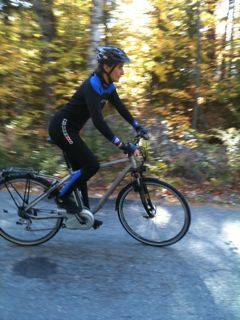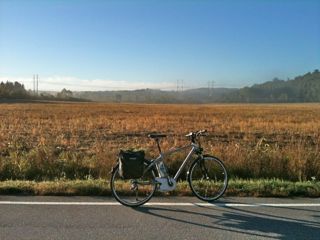Still Water co-director Joline Blais trades a 45-minute car commute for an hour and a quarter on an electric bike.
 For the most part, life in the country is far more sustainable than life in the city. Food is grown minutes rather than hours away, houses are warmed by woodstoves rather than coal plants, and summer sun is ingested by trees instead of absorbed by asphalt. A major exception to this rule is commuting: cityfolk can often hop on the subway, or even better, on their bicycles, and flit across town to work, whereas us country people often live at a sizable distance from our workplaces and other destinations, and there are frequently no public transit options for getting from place to place.
For the most part, life in the country is far more sustainable than life in the city. Food is grown minutes rather than hours away, houses are warmed by woodstoves rather than coal plants, and summer sun is ingested by trees instead of absorbed by asphalt. A major exception to this rule is commuting: cityfolk can often hop on the subway, or even better, on their bicycles, and flit across town to work, whereas us country people often live at a sizable distance from our workplaces and other destinations, and there are frequently no public transit options for getting from place to place.
Fortunately, there’s a solution for greenies whose daily mileage is measured in double digits–as long as they’re willing to trade car exhaust and aggravation for fresh air and taut quad muscles. An electric bike will flatten your environmental impact and pump up your VO2 max at the same time.
 Biking has the lowest carbon footprint of any road transportation besides your own feet. The League of American Bicyclists found bike commuting in the 70 largest cities in the United States climbed 35 percent between 2005 and 2009. Cities and courts are supporting bike lanes despite legal challenges. Still Water Senior Researcher Craig Dietrich bikes to work in Los Angeles. (He’s the only Los Angeleno I know with the guts to cycle his way through LA road rage.) New York has recently seen a huge upsurge in the use of electric bikes for deliveries, even though driving an ebike down Broadway is technically illegal.
Biking has the lowest carbon footprint of any road transportation besides your own feet. The League of American Bicyclists found bike commuting in the 70 largest cities in the United States climbed 35 percent between 2005 and 2009. Cities and courts are supporting bike lanes despite legal challenges. Still Water Senior Researcher Craig Dietrich bikes to work in Los Angeles. (He’s the only Los Angeleno I know with the guts to cycle his way through LA road rage.) New York has recently seen a huge upsurge in the use of electric bikes for deliveries, even though driving an ebike down Broadway is technically illegal.
When Still Water Co-director Joline Blais saw that German-made Kalkhoff bicycles were being distributed in the USA. With slogans like “Uphill is the new downhill” and “Why should Europeans have all the fun?”, Kalkhoff USA established a foothold for high-performance electric bikes at their store in Portland. Unfortunately, it was the other Portland, in Oregon–but no matter. After doing extensive research (the Kalkhoff was later declared best of breed by Wired magazine), Joline ordered a bike sent to Maine, where it was the first of its kind on the east coast.
As shiny and nimble as it looks from a distance, the Kalkhoff is less speedboat than heavy cruiser. Outfitted with 27 gears, a 300-watt motor, and 7-pound lithium-ion battery, it’s ready to go the distance on state routes or backroads. Nifty spring-release saddlebags leave plenty of room for a laptop and dress shoes (we are commuting, right?).
What’s it like to ride? It’s not the Jetsons, where technology takes over and you sit back and watch the scenery fly past. That’s called a moped. With an electric bike, you can still watch the scenery, but you also get in excellent shape if you commute as far as Joline does.
 Which is 25 miles, each way, over a rollercoaster assortment of 500-foot (150-meter) hills between Lucerne and Orono. The Kalkhoff doesn’t do the work for you, but it does give you that extra energy to get over the next hill or keep going against that headwind. (Even the Plug-in Prius will only go 13 miles on a single charge.) And for the athletically inclined, an ebike might actually inspire you to pedal faster rather than sit back and relax. Maybe that’s why Still Water’s ebike commute takes only 50% longer than commuting by car.
Which is 25 miles, each way, over a rollercoaster assortment of 500-foot (150-meter) hills between Lucerne and Orono. The Kalkhoff doesn’t do the work for you, but it does give you that extra energy to get over the next hill or keep going against that headwind. (Even the Plug-in Prius will only go 13 miles on a single charge.) And for the athletically inclined, an ebike might actually inspire you to pedal faster rather than sit back and relax. Maybe that’s why Still Water’s ebike commute takes only 50% longer than commuting by car.
To be sure, that’s an extra half hour we have to budget into our day–but remember, we’ve saved a trip to the gym! While you can jury-rig or buy a cheap electric motor for a regular bike for a couple of hundred dollars, the Kalkhoff tacks another zero onto the end of that figure. Fortunately, an ebike will also save you money in the long run: after a hundred roundtrips per person, the bike will have paid for itself in gas alone–not counting the savings in gym memberships and doctor’s visits.

An excellent choice for your environment AND your body. 🙂